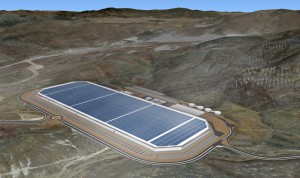
Tesla's Elon Musk said recently that if the automaker reaches its production goal of 500,000 units, it would absorb all of the world's current lithium production. Credit: Tesla
Tesla flung open the doors of its still-in-progress Gigafactory to show the world what kind of progress it’s making on what will likely be the birthplace of every battery stuffed into every Tesla EV sold for years to come.
The company’s founder and CEO, Elon Musk, took the media on a tour of the plant, which is only 14% complete, and announced the facility would begin producing batteries at the end of this year. The first automotive power sources weren’t due to roll off the line, so to speak, until sometime in 2017. Tesla shareholders and owners will get a private tour later this week.
The plant is already producing Tesla’s Powerwall and Powerpack energy storage units, using cells from Panasonic Corp. The Japanese company is a partner, investing $1.6 billion into the site, which is expected to cost $5 billion once it’s completed in 2020.
Right now, 1,000 Gigafactory employees working in shifts, some around the clock, to ensure the company can meet Musk’s optimistic timeline of on-site production by the end of the year. Musk envisions total employment to be about 10,000 when at max production levels.
(Model S speeding at time of fatal crash, NTSB says. For more, Click Here.)
Covering about 2 million square feet right now, it will grow to more than more than 10 million square feet on 3,200 acres in the Nevada desert, 30 minutes east of Reno. The factory will be covered in solar panels equivalent to 107 football fields.
While the fact that Tesla has produced three viable, road-worthy electric vehicles in its 13 years of existence, Musk almost seems more impressed by the development of the new plant.
“The factory has far more potential for innovation than the product itself,” said Musk, noting the herd of wild horses that occupy the property. “I find this to be quite romantic. It feels like the wild West.”
Tesla expects to the factory to produce 35 gigawatt hours of batteries by 2018, which is equal to the entire world’s production two years ago. If the company hits its sales goals of 500,000 vehicles annually by 2018, he’s going to need every battery pack the Gigafactory can produce.
The Model 3, which is the fourth vehicle in the Tesla line-up, is the vehicle that is supposed to take the company from technological curiosity to economic powerhouse and provide the cutting-edge automaker with something hasn’t yet achieved: a profit.
(Tesla plans to improve Autopilot, Musk says. Click Here for more.)
Not only is Tesla feeling the pinch due to battery availability, but also competitors are coming for the upstart company, including established competitors like General Motors and Nissan as well as other not so well-known foes like BYD, Google and possibly Apple.
However, Musk has a plan. A master plan that was a secret until recently when he revealed it to the world. He calls for the California company to flesh out its line-up with an assortment of new battery-electric vehicles, including a “new kind of pickup truck,” as well as an SUV smaller than the current Model X.
But it also appears to envision Tesla as a supplier of a broad range of green technology solutions, a move that is based on its planned acquisition of solar panel company SolarCity.
The theme of the Master Plan is “sustainability,” said Musk, in an almost apocalyptic blog post warning of dire consequences if the world doesn’t get off its oil fix.
(To see more about Tesla’s “master plan,” Click Here.)
“By definition, we must at some point achieve a sustainable energy economy or we will run out of fossil fuels to burn and civilization will collapse,” he wrote. “Given that we must get off fossil fuels anyway and that virtually all scientists agree that dramatically increasing atmospheric and oceanic carbon levels is insane, the faster we achieve sustainability, the better.”

Crazy times we live in … electric cars will take over the world in the next ten years!